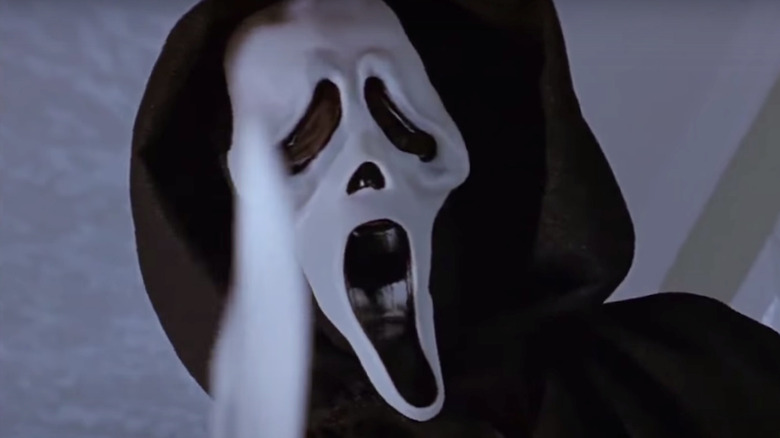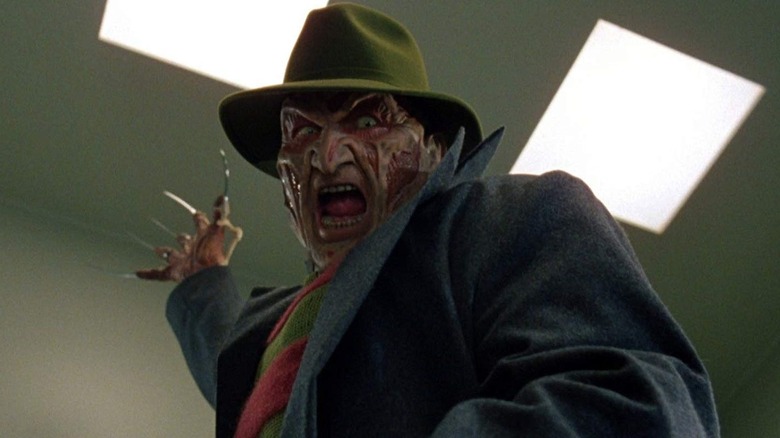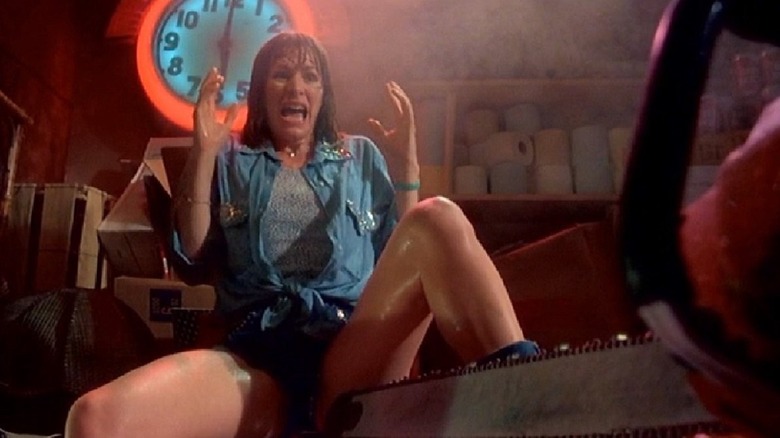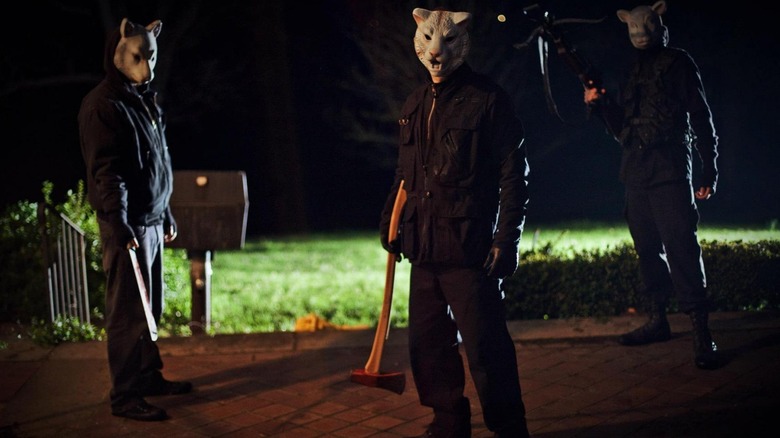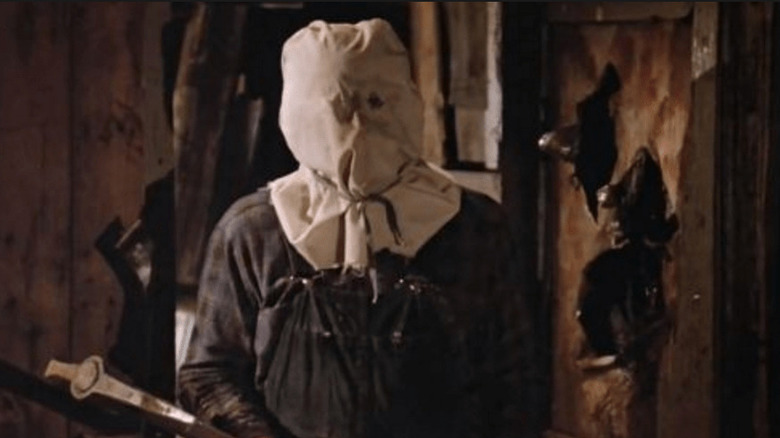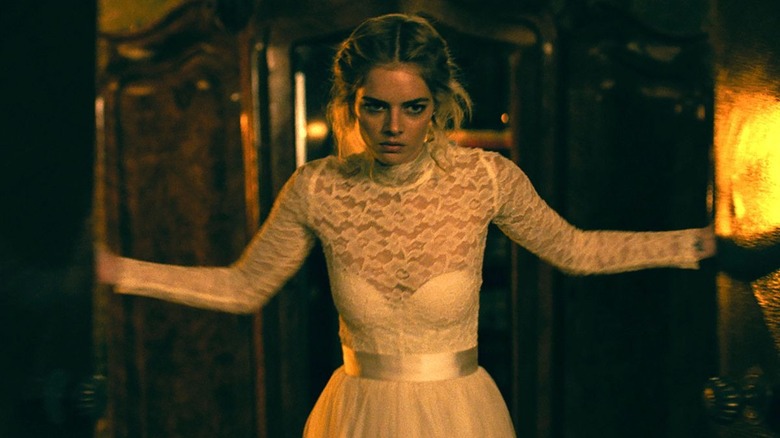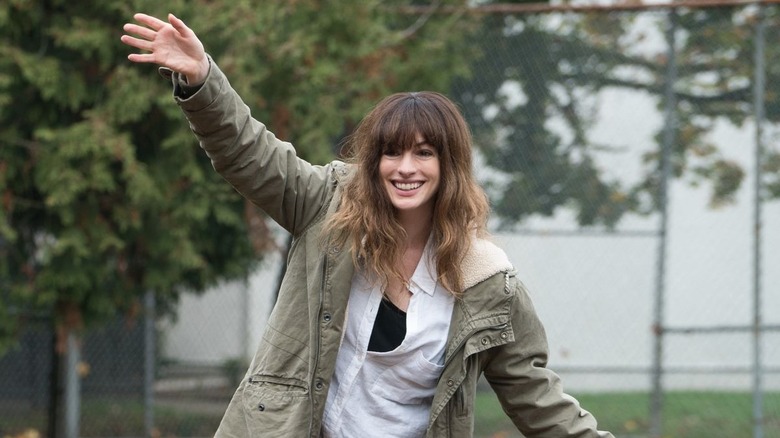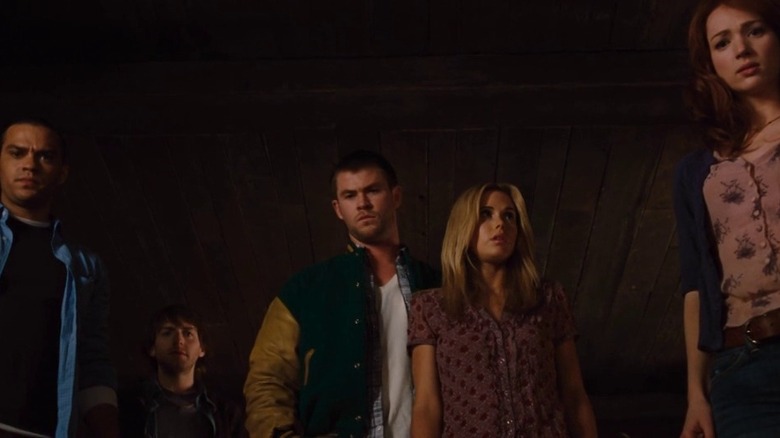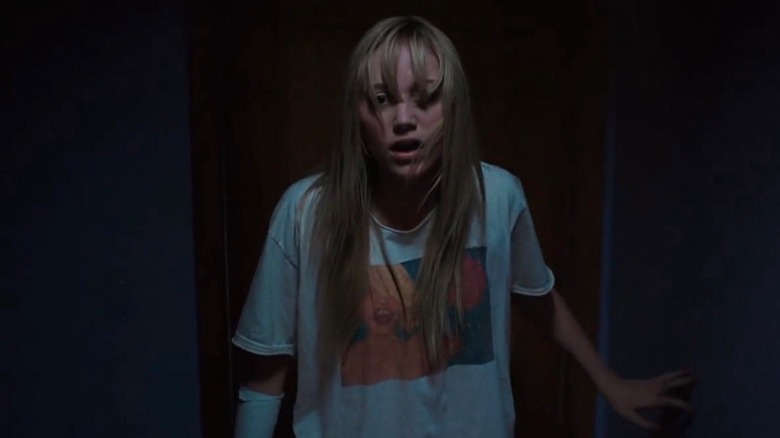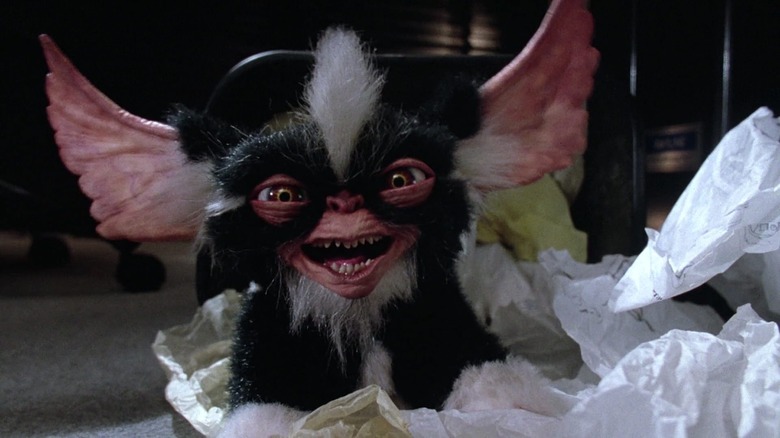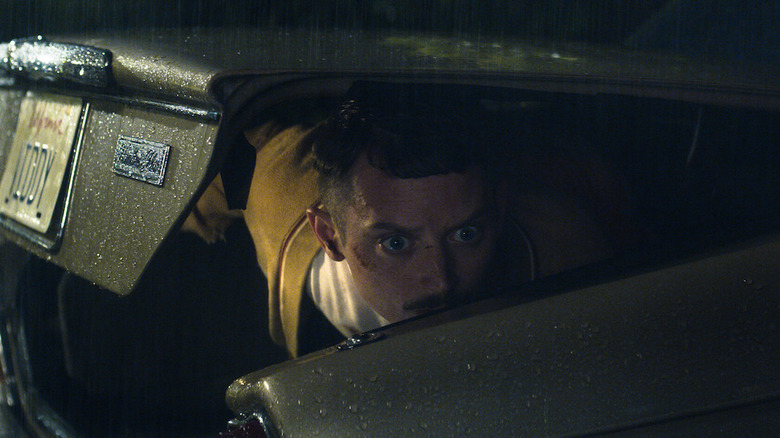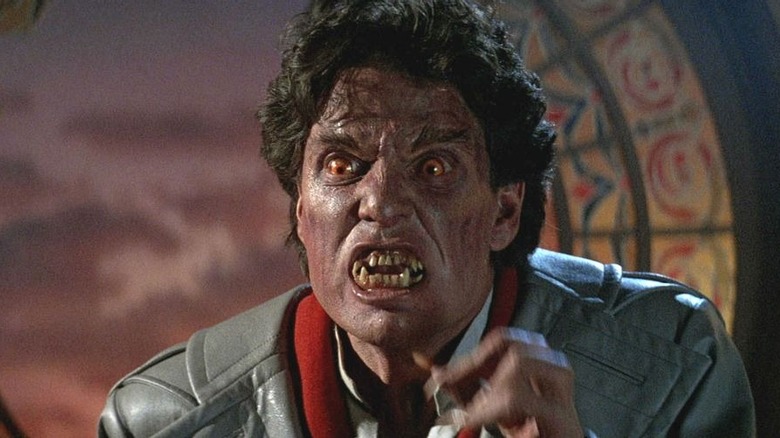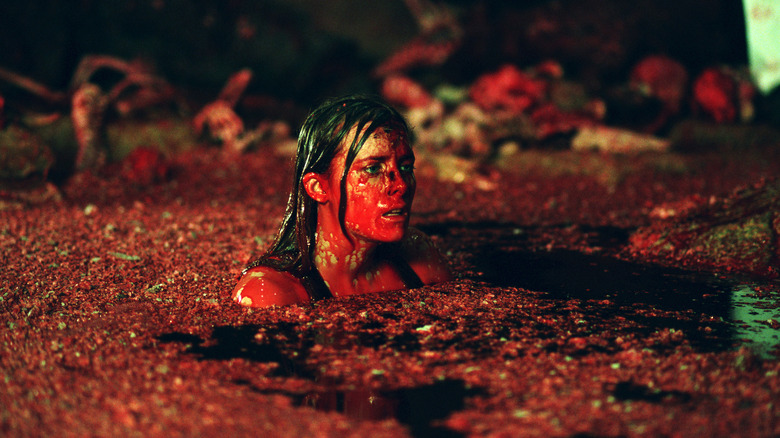12 Movies Like Scream Horror Fans Need To See
"Scream" is one of the quintessential horror movies of the '90s. Not only a terrifying update to the slasher genre, Wes Craven's landmark film included social satire within its visceral thrills. The film landed with such an impact that it has been discussed in relation to instances of true crime.
"Scream" was unique because it acknowledged that the slasher genre itself had grown tired and filled with clichés. Instead of replicating the poor decision making that was common in horror films, the protagonists of "Scream" are already familiar with the quintessential horror favorites. They reference what characters in a film would do, and Craven has fun referencing both his own contributions to the genre and other beloved classics.
As the "Halloween," "Friday the 13th," and Craven's own "A Nightmare on Elm Street" franchises declined in quality, it was up to a new franchise to continue the slasher legacy. The "Scream" series is notable for its consistency. "Scream 2" satirized the very notion of sequels, "Scream 3" took the characters directly to Hollywood, and "Scream 4" reintroduced the Ghostface mystery to a younger generation.
Expectations are high for the upcoming fifth installment set to hit theaters next January, simply titled "Scream." Although it will be the first entry in the series without Craven, who passed away in 2015, the new film reunites original cast members Neve Campbell, David Arquette, and Courtney Cox.
The influence of "Scream" is undeniable, and fans will want to check out these other great horror films.
Wes Craven's New Nightmare
Wes Craven's 1984 classic "A Nightmare on Elm Street" is one of the quintessential slasher films, and Freddy Krueger joined the pantheon of great screen antagonists. The concept of a relentless killer that preyed upon his victims as they slept was horrifying, and Craven's incorporation of fantasy elements produced some of the most visceral kills in horror history. Unfortunately, the subsequent entries that lacked Craven's direct involvement failed to retain that legacy.
Freddy grew increasingly silly in the five sequels; less of a silent nightmare and more of an eccentric comedian, Robert Englund's fearsome character was no longer scary. Craven helped co-write the third film "A Nightmare on Elm Street 3: Dream Warriors," which leaned back into his initially gritty approach and temporarily re-energized the series. However, by the time of the sixth film "Freddy's Dead: The Final Nightmare," the once terrifying villain was a complete joke.
Thankfully, Craven returned to the series with his 1994 meta sequel "Wes Craven's New Nightmare." Set outside of the continuity of the other films, the seventh entry showed Freddy breaking out from the movie screen and haunting the original cast from the films themselves. Although this led to some self-aware humor, particularly when Craven makes a cameo as himself, the film took a more serious approach to dream anxiety. "New Nightmare" wasn't immediately hailed for being a breakthrough, but the self-aware tone set the precedent for Craven to helm "Scream" two years later.
The Texas Chainsaw Massacre 2
1974's "The Texas Chainsaw Massacre" is one of the signature slasher films, and introduced the terrifying Leatherface to audiences. Similar to "Scream," the film became a media sensation that unnerved many viewers, in part due to the misleading title card that claimed that it was a true story. It was banned in several countries and subject to criticism for its extreme violence, and created one of the most notable "final girls" in horror history with Marily Burns's Sally Hardesty.
However, the slasher genre changed dramatically in the decade following Leatherface's screen debut, as the terrifying tone that director Tobe Hooper originally envisioned became lost amidst a sea of campy imitators. His 1986 sequel "The Texas Chainsaw Massacre 2" took a darkly comic approach, using eccentric characters and over-the-top death sequences for a satirical purpose.
The first film is gradual in establishing its characters and their seedy environment, but in the sequel the carnage starts immediately. Two drunk and rowdy college boys loudly blare music as they burst down a Texas highway, and Leatherface graphically dismembers them in a fashion more violent than anything in the original.
Like "Scream," "The Texas Chainsaw Massacre 2" centers on female empowerment. The film's final girl Stretch Brock (Caroline Williams) weaponizes Leatherface's childlike sexuality when he attempts to assault her, and she victoriously imitates his joyful dance in the film's last scene.
You're Next
The home invasion sequence that opens "Scream" sets the story up with a terrifying hook. A breach of security is an inherently terrifying concept, and Ghostface meticulously breaks down Casey Becker's (Drew Barrymore) sense of security as he goads her with questions about slasher film history. It was particularly frightening considering Barrymore was central to the film's marketing campaign, and many viewers expected her to be one of the main characters in the film.
Adam Wingard's 2011 festival breakout "You're Next" (released theatrically two years later) is one of the most effective recent home invasion films. "Scream" contains the home invasion sequence to its opening scene, and it's hard for a feature length film to maintain a consistent tension without breaking from reality. The characters need to have a believable reason for remaining in the hostile environment, and in "You're Next" the decisions the characters make are logical.
Ghostface was a great slasher because his methods of dismemberment are unique, and he trapped victims in elaborate displays. The enigmatic "Fox Mask" killer in "You're Next" is similarly inventive, using a crossbow and other medieval weapons to threaten the denizens of a log cabin.
Like "Scream," "You're Next" has a compelling mystery that ends with a shocking twist about the killer's identity. Neither film is as straightforward as it may seem initially, and "You're Next" reveals surprising details about both its killer and victims. Both films justify their savagery by using violence as a social critique.
Friday the 13th Part 2
In the opening sequence to "Scream," Ghostface questions Barrymore's character about trivia about famous slasher films, including the "Friday the 13th" franchise. Any incorrect response will result in her death, and the question that ultimately dooms her is in regards to the killer in "Friday the 13th." She screams that it's Jason Voorhees, and Ghostface revels in her incorrect answer. It's Jason's mother who does the killing in the 1980 original; Jason himself doesn't become the antagonist until the 1981 sequel "Friday the 13th Part 2."
The second film did more than introduce Jason. It set the tone for the entire franchise, and amidst the twelve installments, "Friday the 13th Part 2" stands as one of the best. Before he became a caricature, Jason represented a primal unrelenting rage that haunted the unsuspecting teenage camp counselors of Camp Crystal Lake. It's one of the rare films in the series that stands on its own. The later entries became so convoluted by the mythology that they're harder to watch individually.
Like "Scream," there's a wittiness and accuracy to the depiction of teenage interaction in "Friday the 13th Part 2." The gang of counselors have realistic dialogue, and the characters are made distinct before they meet their doom.
Ready or Not
Expectations are incredibly high for next year's "Scream" sequel, and fans are rightfully skeptical about continuing the meta franchise after its original creator Wes Craven has passed away. Craven is one of the greatest horror directors of all-time. He launched many successful franchises including "The Hills Have Eyes" and "A Nightmare on Elm Street," but "Scream" is the only saga in which he personally helmed every sequel. The recent MTV spinoff series failed to capture Craven's unique voice.
However, fans can rest assured that next year's "Scream" is in good hands with directors Matt Bettinelli-Olpin and Tyler Gillett, and their co-writer Guy Busick. The trio known as Radio Silence previously worked together on the excellent dark comedy slasher film "Ready or Not" in 2019. The playfully twisted film struck the same blend between brutality and social satire that Craven did best.
The film follows Grace Le Domas (Samara Weaving), who is brought into the eccentric Le Domas family upon her wedding with Alex (Mark O'Brien). Grace is uncomfortable, as the wealthy Le Domas clan celebrates in a massive medieval castle and has a unique tradition: they welcome new members with party games. Grace discovers that they actually intend to trap her within the secluded mansion and hunt her with medieval weapons, and she's forced to survive the night and avoid her husband's wacky relatives. Like Sidney Prescott, Grace is a savvy and intelligent final girl.
Colossal
Although "Scream" has many great gags centered on '90s teen culture and stereotypes within horror fiction, the subtext is ultimately serious. Sidney is dealing with the traumatic loss of her mother one year prior, and must cope with her guilt throughout the film — especially after she becomes a media darling and is constantly reminded of the tragedy. Ghostface threatens Sidney by recreating the gruesome scene, and claims he was involved. Horror is often centered on trauma, and the underrated dark comedy monster movie "Colossal" finds a similarly sensitive vibe to "Scream."
At times it's hilarious, but its depiction of abusive relationships and alcoholism are done with respect. Anne Hathaway stars as the unemployed writer Gloria, who returns to her hometown after she's dumped by her boyfriend Tim (Dan Stevens). Gloria suffers from addiction and depression, and while her home initially provides some comfort, she's reminded of the past when she encounters her childhood friend Oscar (Jason Sudeikis). The seemingly "nice guy" is a toxic abuser who bullied Gloria in their youth.
The horror slant is introduced when Gloria discovers she has the power to control a giant kaiju monster. "Colossal" does for the "Godzilla" franchise what "Scream" did for slashers, and uses the massive creatures as a metaphor for identity. Gloria grows empowered by her secret abilities to comedic effect, but the situation grows more serious when Oscar also takes on a monstrous second form.
The Cabin in the Woods
"Scream" begins with a seemingly straightforward premise. The initial setup of a masked killer haunting a body of high school students is hardly original, but as Sidney and her friends explore the mystery of Ghostface's identity, there are surprises. The Ghostface killers Billy Loomis (Skeet Ulrich) and Stu Macher (Matthew Lillard) are responding to the events they've seen in horror media. Billy tells Sidney that "Movies don't create psychos. Movies make psychos more creative!"
The awareness of existing media made "Scream" stand out, as audiences could relate to characters that were actively subverting stereotypes. The brilliant 2012 horror comedy "The Cabin in the Woods" took a similar approach, deceiving viewers with its straightforward beginning. "The Cabin in the Woods" begins like any other "Evil Dead" wannabe, with five college friends preparing for a vacation in the middle of a secluded forest.
Each of the characters represents a common horror archetype. Dana Polk (Kristen Connolly) is "The Virgin," Curt Vaughan (Chris Hemsworth) is "The Athlete," Jules Louden (Anna Hutchinson) is "The Whore," Holden McCrea (Jesse Williams) is "The Scholar," and Marty Mikalsk (Fran Kranz) is "The Fool." As the characters are picked off one by one by demonic creatures, it's revealed that their decisions are being influenced by an underground lair of lab workers. The wry screenplay by Joss Whedon and Drew Goddard pokes fun at splatter films in the same way "Scream" responds to slasher films.
It Follows
"Scream" isn't just a horror masterpiece, it's one of the quintessential teen films of the '90s. The depiction of the MTV generation was realistic in showing adolescent interactions and the pressures of high school cliques. It's one thing for Sidney to deal with a demented killer who targets her trauma, but its another to deal with obnoxious bullies and adults who don't respect her individuality. The depiction of young sexuality is particularly earnest; Sidney feels the pressure to be intimate with her boyfriend Billy, and the film reflects on how common it is for horror films to idealize virginity.
David Robert Mitchell's 2015 horror film "It Follows" also addresses these anxieties with its commentary on teenage sexual exploration. A mysterious supernatural entity is passed between young people as a sexually transmitted disease. The characters fear intimacy because of this demonic force, a clever metaphor for "slut shaming," restrictive communities, and the HIV/AIDS crisis. "It Follows" creates suspense because the characters are in fear of admitting their sexuality to each other, and the older characters only stigmatize them. Like "Scream," "It Follows" appealed to young viewers with a premise they could relate to.
Gremlins 2: The New Batch
"Scream" examined the media's desensitization to violence, correlating the crimes of Billy and Stu with the frequent news coverage of true crime and graphic violence in films. The shocking events are sensationalized by reporters in a response to similar trends in '90s television and film culture. Craven didn't demonize Hollywood or journalism, but he made a powerful statement. Craven made his message more palatable through black comedy, pushing the third party commentators to ridiculous extremes.
Director Joe Dante also had more ambitious themes in mind when he crafted his 1990 sequel "Gremlins 2: The New Batch." Dante's first "Gremlins" film was definitely silly, but the second film lampoons Hollywood's greed and unoriginality by being as ridiculous as possible. The campiness stems from business tycoons and mad scientists who recklessly create a dangerous situation, experimenting with the furry creatures without any regards to collateral damage.
Like "Scream," there are many references to established classics, and it's an essential watch for film buffs. Craven used "Scream" to voice his own dissatisfaction with the ways the horror genre had changed, even referencing the sequels to his own "A Nightmare On Elm Street" series. Dante looked at Hollywood's entire history with "Gremlins 2: The New Batch," and "The Wizard of Oz," "First Blood," "Marathon Man," and "The Phantom of the Opera" are just some of the films spotlighted.
Come to Daddy
"Scream" presents a compelling dramatic parental relationship between Sidney and her father Neil Prescott (Lawrence Hecht). Both are shell-shocked by the recent loss of Sidney's mother Maureen (Lynn McRee), and are unable to return to the comfortably open relationship they once had. Sidney's isolation determines much of her behavior, but she ultimately is able to move on from the tragedy and engage fully with her father once more. The dramatic character work makes the scares more compelling.
Ant Timpson's highly underrated 2020 film "Come to Daddy" explores similar themes of parental abandonment within a horror premise. Elijah Wood stars as the music executive Norval Greenwood, who receives a mysterious invitation by his estranged father Brian (Stephen McHattie) to join him in an isolated cabin in the middle of nowhere. Norval isn't initially likeable like Sidney, but his father's longtime absence helped develop his cynical, pretentious attitude.
"Come to Daddy" takes a subversive twist when Norval discovers that his father's identity is more complex than he imagined. Similar to "Scream," there's a compelling mystery to match the pulpy thrills.
Fright Night
"Scream" can't be defined by just one genre. It is simultaneously a horror classic, a commentary on '90s film culture, a compelling teenage drama, and an intricately staged noir. Films that transcend genres often have crossover appeal — and the 1985 film "Fright Night" combines elements of suspense, vampire horror, teen comedy, and mystery.
The unpredictable film was loosely inspired by the premise of Alfred Hitchcock's classic "Rear Window," as the main character is forced to piece together clues to a mystery while trapped in a single location. Geeky teenager Charley Brewster (William Ragsdale) spends most evenings obsessing in his room about the television vampire hunter Peter Vincent (Roddy McDowall). However, he begins to suspect that his new neighbor Jerry Dandrige (Chris Sarandon) may be an actual vampire. Like Sidney's difficulties, Charley's plight is relatable to teenagers; no one believes him when he pieces together evidence of Jerry's malicious nighttime activities. There's also a cheeky framing device utilized once Vincent and Charley cross paths.
The villainous Billy and Stu are compelling in "Scream" because of their initially welcoming personas; Sarandon's eccentric protagonist is similarly charismatic in the beginning of "Fright Night."
The Descent
The pain of her mother's loss haunts Sidney's journey throughout "Scream." She's given little time to mourn, and she's constantly at odds with the expectation that she needs to return to a sense of normalcy. Even though she's able to make it through her everyday life under the guise that she's recovered, Sidney is reminded of her trauma amidst the Ghostface crisis.
Neil Marshall's 2005 underground horror film "The Descent" tackles similar themes of healing. The film establishes its gripping tragedy in the opening moments: deep cave explorer Sarah Carter (Shauna Macdonald) is involved in a car accident where her husband and young daughter perish. The loss makes Sarah reluctant to take up her passion once more, but a year later she joins a group of friends in a spelunking vacation to ease her mind.
Unfortunately, Sarah and her friends become trapped deep within a mysterious cave where they're preyed upon by demonic creatures. Marshall's claustrophobic environments and sickening body horror are bone-tingling, but Sarah's emotional character arc is integral to "The Descent's" effectiveness.
